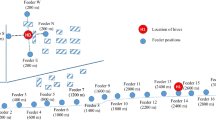Summary
Early studies of dance communication inApis florea had shown that waggle dances are not performed on a vertical plane and oriented to gravity, as in the other species ofApis, but instead take place on the flattened top of the exposed comb and are oriented to celestial cues directly. More recent experiments showed thatA. florea can dance in the absence of a view of the sun or blue sky, but did not establish what mechanism permitted this orientation. I now report that dances can be oriented directly to landmarks visible from the nest, the first evidence of an environmental feature other than celestial cues or gravity being involved in dance orientation. Landmarks near the nest are probably used to refer to celestial cues, in a fashion analogous to the use of broad features of the landscape by honeybees in order to learn the sun's course, which permits them to determine their flight angle on overcast days or at night, and to compensate accurately for solar movement.Apis florea may therefore be able to learn the sun's course with respect to two sets of landmarks.
In other experiments I have examined the influence of slope onA. florea's dance orientation to visual references. In the first extensive observations of its dances on a vertical plane, I have amply confirmed that this species cannot transpose light and gravity in setting its dance angle, as the other species ofApis can. Nor do dancers orient so as to match visual information seen during the dance with that remembered from the flight. Patterns in the data when the same patch of sky was presented from different angles suggest instead thatA. florea continues to orient to projections of celestial cues onto the horizontal plane even when dancing on a steep slope. This compensation for slope may involve an ability to detect gravity and factor it out in aligning the dance to celestial cues.
These insights suggest thatA. florea's dance orientation system has been adapted to requirements imposed by its nesting behavior, and has diverged sharply from the system shared by the other species ofApis.
Similar content being viewed by others
References
Batschelet E (1965) Statistical methods for the analysis of problems in animal orientation and certain biological rhythms. American Institute of Biological Sciences, Washington DC
Batschelet E (1972) Recent statistical methods for orientation data. In: Galler SR, Schmidt-Koenig K, Jacobs GJ, Belleville RE (eds) Animal orientation and navigation. US Government Printing Office, Washington DC, pp 61–92
Beier W, Lindauer M (1970) Der Sonnenstand als Zeitgeber für die Biene. Apidologie 1:5–28
Brines ML, Gould JL (1982) Skylight polarization patterns and animal orientation. J Exp Biol 96:69–91
DeJong D (1982) The orientation of comb-building by honey bees. J Comp Physiol 147:495–501
Dyer FC (1984) PhD thesis, Princeton University
Dyer FC (1985) Nocturnal orientation of the Asian honey beeApis dorsata. Anim Behav 33:769–774
Dyer FC, Gould JL (1981) Honey bee orientation: a backup system for cloudy days. Science 214:1041–1042
Dyer FC, Gould JL (1983) Honey bee navigation. Am Sci 71:587–597
Edrich W (1977) Interaction of light and gravity in the orientation of the waggle dance of honey bees. Anim Behav 25:342–363
Frisch K von (1946) Die Tänze der Bienen. Oester Zool 1:1–32
Frisch K von (1949) Die Polarisation des Himmelslichtes als orientierender Faktor bei den Tänzen der Bienen. Experientia 5:142–148
Frisch K von (1962) Über die durch Licht bedingte Missweisung bei den Tänzen im Bienenstock. Experientia 18:49–53
Frisch K von (1967) The dance language and orientation of bees. Belknap/Harvard, Cambridge, Massachusetts
Frisch K von, Lindauer M (1954) Himmel und Erde in Konkurrenz bei der Orientierung der Bienen. Naturwissenschaften 41:245–253
Frisch K von, Lindauer M, Schmiedler F (1960) Wie erkennt die Biene den Sonnenstand bei geschlossener Wolkendecke? Naturwiss Rundschau: 169–172
Gould JL, Kirschvinck JL, Deffeyes KS, Brines ML (1980) Orientation of demagnetized bees. J Exp Biol 86:1–8
Hölldobler B (1980) Canopy orientation: a new kind of orientation in ants. Science 210:86–88
Horn E (1973) Die Verarbeitung des Schwerereizes bei der Geotaxis der höheren Bienen (Apidae). J Comp Physiol 82:397–406
Horn E (1975) Mechanisms of gravity processing by leg and abdominal gravity receptors in bees. J Insect Physiol 21:673–679
Jander R (1957) Die optische Richtungsorientierung der roten Waldameise (Formica rufa L.). Z Vergl Physiol 40:162–238
Jander R, Jander U (1970) Über die Phylogenie der Geotaxis innerhalb der Bienen (Apoidea). Z Vergl. Physiol 66:355–368
Koeniger N (1976) Neue Aspekte der Phylogenie innerhalb der GattungApis. Apidologie 7:357–366
Koeniger N, Koeniger G (1980) Observations and experiments on migration and dance communication ofApis dorsata in Sri Lanka. J Apic Res 19:21–34
Koeniger N, Koeniger G, Punchihewa RKW, Fabritius Mo, Fabritius Mi (1982) Observations and experiments on dance communication ofApis florea in Sri Lanka. J Apic Res 21:45–52
Lindauer M (1956) Über die Verständigung bei indischen Bienen. Z Vergl Physiol 38:521–557
Lindauer M (1960) Communication among social bees. Harvard, Cambridge, Massachusetts
Lindauer M (1976) Recent advances in the orientation and learning of honey bees. Proc 15th Int Congr Entomol:450–460
Martin H, Lindauer M (1977) Der Einfluß des Erdmagnetfeldes auf die Schwereorientierung der Honigbiene. J Comp Physiol 122:145–187
Seeley TD, Seeley RH, Akratanakul P (1982) Colony defense strategies of the honey bees in Thailand. Ecol Monogr 52:43–63
Wehner R (1981) Spatial vision in arthropods. In: Autrum H (ed) Invertebrate photoreception. Springer, Berlin Heidelberg New York (Handbook of sensory physiology, vol VII/6 C, pp 287–616)
Wehner R (1982) Himmelsnavigation bei Insekten: Neurophysiologie und Verhalten. Neujahrsbl Naturforsch Ges Zürich 184:1–132
Wehner R (1984) Astronavigation in insects. Annu Rev Entomol 29:277–298
Wehner R, Rossel S (1985) The bee's celestial compass — A case study in behavioural neurobiology. In: Hölldobler B, Lindauer M (eds) Experimental behavioural ecology. G Fischer, Stuttgart New York (Fortschr Zool 31, pp 11–53)
Author information
Authors and Affiliations
Rights and permissions
About this article
Cite this article
Dyer, F.C. Mechanisms of dance orientation in the Asian honey beeApis florea L.. J. Comp. Physiol. 157, 183–198 (1985). https://doi.org/10.1007/BF01350026
Accepted:
Issue Date:
DOI: https://doi.org/10.1007/BF01350026




